Wireless Dynamic Sensor Network for Water Quality Monitoring Based on the IoT
Abstract
:1. Introduction
Related Works
2. Methodology
2.1. Water Quality Monitoring Sensors
2.2. Data Acquisition and Steering Control Systems
2.3. Communication Model for WDSN
2.3.1. Communication Channel on OPC Servers
2.3.2. Node Communication Systems
2.3.3. Network Sizing
2.4. Data Management
2.5. Prototype Designing Process
2.5.1. Static Node CAD Model
2.5.2. Mobile Node CAD Model
2.5.3. Electrical Schematic and PCB Layout
3. Implementation
4. Results and Discussion
5. Conclusions
Author Contributions
Funding
Data Availability Statement
Conflicts of Interest
References
- Al Jazeera. Al Jazeera Staff. 22 March 2022. Available online: https://www.aljazeera.com/news/2022/3/22/infographic-which-countries-have-the-safest-drinking-water-interactive (accessed on 4 March 2024).
- Drasovean, R.; Murariu, G. Water Quality Parameters and Monitoring Soft Surfece Water Quality Using Statistical Approaches. In Promising Techniques for Wastewater Treatment and Water Quality Assessment; Intech Open: London, UK, 2021; pp. 217–230. [Google Scholar]
- Wiryasaputra, R.; Huang, C.-Y.; Lin, Y.-J.; Yang, C.-T. An IoT Real-Time Potable Water Quality Monitoring and Prediction Model Based on Cloud Computing Architecture. Sensors 2024, 24, 1180. [Google Scholar] [CrossRef] [PubMed]
- Chhipi-Shrestha, G.; Mian, H.R.; Mohammadiun, S.; Rodriguez, M.; Hewage, K.; Sadiq, R. Digital water: Artificial intelligence and soft computing applications for drinking water quality assessment. Clean Techn. Environ. Policy 2023, 25, 1409–1438. [Google Scholar] [CrossRef]
- Tazoe, H. Water quality monitoring. Anal. Sci. 2023, 39, 1–3. [Google Scholar] [CrossRef] [PubMed]
- Ullo, S.L.; Sinha, G.R. Advances in Smart Environment Monitoring Systems Using IoT and Sensors. Sensors 2020, 20, 3113. [Google Scholar] [CrossRef] [PubMed]
- Uddin, M.G.; Nash, S.; Olbert, A.I. A review of water quality index models and their use for assessing surface water quality. Ecol. Indic. 2021, 122, 107218. [Google Scholar] [CrossRef]
- Atiast, A.A.; Aljafaar, K.D. Automation system for monitoring the quality of water sources to maintain their sustainability using microcontrollers. In Proceedings of the International Conference of Electrical, Computer and Energy Technologies (ICECET), Prague, Czech Republic, 20–22 July 2022; pp. 1–4. [Google Scholar]
- Islam, M.A.; Khan, R.H.; Syeed, M. A Smart and Integrated Surface Water Monitor System Architecture: Bangladesh Perspective. In Proceedings of the International Conference on Computing Advancements, Dhaka, Bangladesh, 10–12 January 2020. [Google Scholar]
- Chen, S.L.; Chou, H.S.; Huang, C.H.; Chen, C.Y.; Li, L.Y.; Huang, C.H.; Chen, Y.Y.; Tang, J.H.; Chang, W.H.; Huang, J.S. An Intelligent Water Monitoring IoT System for Ecological Environment and Smart Cities. Sensors 2023, 23, 8540. [Google Scholar] [CrossRef]
- La salud Pública Depende en Gran Medida del Acceso y Calidad del Agua. Gobierno de México, 13 July 2021. Available online: https://www.gob.mx/imta/es/articulos/la-salud-publica-depende-en-gran-medida-del-acceso-y-calidad-del-agua (accessed on 20 April 2024).
- Alertan Riesgo para 30 Millones de Mexicanos por Consumo de Agua de Mala Calidad. 25 April 2023. Available online: https://www.infobae.com/mexico/2023/04/25/alertan-riesgo-para-30-millones-de-mexicanos-por-consumo-de-agua-de-mala-calidad/ (accessed on 25 April 2024).
- El 70% del Agua que Consumimos está Contaminada: Agua en México. NACION, 17 June 2021. Available online: https://lasillarota.com/nacion/2021/6/17/el-70-del-agua-que-consumimos-esta-contaminada-agua-en-mexico-284428.html (accessed on 20 May 2024).
- Calidad del Agua en México. Gobierno de México, 28 February 2024. Available online: https://www.gob.mx/conagua/articulos/calidad-del-agua (accessed on 25 April 2024).
- Mohseni, F.; Saba, F.; Mirmazloumi, S.M.; Amani, M.; Mokhtarzade, M.; Jamali, S.; Mahdavi, S. Ocean water quality monitoring using remote sensing techniques: A review. Mar. Environ. Res. 2022, 18, 105701. [Google Scholar] [CrossRef] [PubMed]
- Imran, L.B.; Latif, R.M.A.; Farhan, M.; Aldabbas, H. Smart City Based Autonomous Water Quality Monitoring System Using WSN. Wirel. Pers. Commun. 2020, 115, 1805–1820. [Google Scholar] [CrossRef]
- MYadav, M.; Preety Saxena, E.; Das, A. Smart Agriculture System Using Artificial Intelligence and Internet of Things. In Reshaping Intelligent Business and Industry: Convergence of AI and IoT at the Cutting Edge; Wiley: Hoboken, NJ, USA, 2024; pp. 403–418. [Google Scholar]
- Parri, L.; Parrino, S.; Peruzzi, G.; Pozzebon, A. LoRaWAN Network Infrastructure for the Remote Monitoring of Offshore Sea Farms. In Proceedings of the 2020 IEEE International Instrumentation and Measurement Technology Conference (I2MTC), Dubrovnik, Croatia, 25–28 May 2020; pp. 1–6. [Google Scholar]
- Rani, S.; Koundal, D.; Kavita; Ijaz, M.F.; Elhoseny, M.; Alghamdi, M.I. An Optimized Framework for WSN Routing in the Context of Industry 4.0. Sensors 2021, 21, 6474. [Google Scholar] [CrossRef] [PubMed]
- Adu-Manu, K.S.; Engmann, F.; Sarfo-Kantanka, G.; Baiden, G.E.; Dulemordzi, B.A. WSN Protocols and Security Challenges for Environmental Monitoring Applications: A Survey. Sensors 2022, 2022, 1628537. [Google Scholar] [CrossRef]
- Prapti, D.R.; Mohamed Shariff, A.R.; Che Man, H.; Ramli, N.M.; Perumal, T.; Shariff, M. Internet of Things (IoT)-based aquaculture: An overview of IoT application o water quality monitoring. Rev. Aquac. 2022, 14, 979–992. [Google Scholar] [CrossRef]
- Feng, C.; Yuan, J.; Sun, Y.; You, J. Design of Water Quality Monitoring System. In Proceedings of the International Conference on Artificial Intelligence and Computer Engineering (ICAICE), Beijing, China, 23–25 October 2020. [Google Scholar]
- Chowdury, M.S.U.; Emran, T.B.; Ghosh, S.; Pathak, A.; Alam, M.M.; Absar, N.; Andersson, K.; Hossain, M.S. IoT Based Real-time River Water Quality Monitoring System. Procedia Comput. Sci. 2019, 155, 161–168. [Google Scholar] [CrossRef]
- Budiarti, R.P.N.; Tjahjono, A.; Hariadi, M.; Purnomo, M.H. Development of IoT for Automated Water Quality Monitoring System. In Proceedings of the International Conference on Computer Science, Information Technology, and Electrical Engineering (ICOMITEE), Jember, Indonesia, 16–17 October 2019. [Google Scholar]
- Roque-Cilia, S.; Tamariz-Flores, E.I.; Torrealba-Meléndez, R.; Covarrubias-Rosales, D.H. Transport tracking through communication in WDSN for smart cities. Measurement 2019, 139, 205–212. [Google Scholar] [CrossRef]
- Pasika, S.; Gandla, S.T. Smart water quality monitoring system with cost-effective using IoT. Heliyon 2020, 6, e04096. [Google Scholar] [CrossRef] [PubMed]
- Stephens, E. Understanding The PH Level Of Ammonia: Importance, Monitoring, And Correcting Methods. AquaWorldHub, 7 March 2024. Available online: https://aquaworldhub.com/ph-level-of-ammonia/ (accessed on 18 April 2024).
- What Is NTU. TECNOCONVERTING Engineering. Available online: https://www.tecnoconverting.com/technical-articles/what-is-ntu/ (accessed on 20 March 2024).
- Conductivity (EC) vs Total Dissolved Solids (TDS)—What’s the Difference? Atlas Scientific, 4 March 2024. Available online: https://atlas-scientific.com/blog/conductivity-vs-tds/ (accessed on 18 April 2024).
- Tomas, L. How to Convert Tds to Conductivity. SCIENCING, 5 December 2020. Available online: https://sciencing.com/convert-conductivity-concentration-6925703.html (accessed on 17 April 2024).
- WHO. Guidelines for Drinking-Water Quality: Fourth Edition Incorporating the First and Second Addenda; World Health Organization: Geneva, Switzerland, 2022. [Google Scholar]
- NOM-127-SSA1-2021; Agua para uso y Consumo Humano. Límites Permisibles de la Calidad del Agua. Secretaría de Salud, Diario Oficial de la Federación: México City, Mexico, 2022.
- Hameed, M.S.; Ramya, E.; Pillai, L.; Kirubavathy, K.J.; Shylesh, D.D.; Bai, V.T.; Jaganathan, R. Realtime Monitoring System for Surface Water Quantity and Analyzing of Water Quality Using Microcontroller. J. Pharm. Negat. Results 2022, 13, 442–447. [Google Scholar]
- Goblirsch, T.; Mayer, T.; Penzel, S.; Rudolph, M.; Borsdorf, H. In Situ Water Quality Monitoring Using an Optical Multiparameter Sensor Probe. Sensors 2023, 23, 9545. [Google Scholar] [CrossRef] [PubMed]
- Singh, Y.; Walingo, T. Smart Water Quality Monitoring with IoT Wireless Sensor Networks. Sensors 2024, 24, 2871. [Google Scholar] [CrossRef] [PubMed]
- Chen, S.T.; Lin, S.S.; Lan, C.W.; Chou, T.I. Design and development of a LoRa based water quality monitoring system. In Proceedings of the International Symposium on Intelligent Signal Processing and Communication Systems (ISPACS), Hualien, Taiwan, 16–19 November 2021. [Google Scholar]
- Prabowo, O.M.; Tresnawati, Y.; Kusumastuti, D. Design of Water Quality Monitoring System using Remote Operated Vehicle. In Proceedings of the International Conference on ICT for Smart Society (ICISS), Bandung, Indonesia, 19–20 November 2020. [Google Scholar]
- Caballero, B.; Finglas, P.M.; Toldrá, F. pH: Principles and Measurements. In Encyclopedia of Food and Health; Elsevier: Amsterdam, The Netherlands, 2016; pp. 333–338. [Google Scholar]
- Christian, G.D.; Dasgupta, P.K.; Schug, K.A. Analytical Objectives, or: What Analytical Chemists Do. In Analytical Chemistry; Wiley: Hoboken, NJ, USA, 2014; pp. 2–216. [Google Scholar]
- Sugiharto, W.H.; Susanto, H.; Prasetijo, A.B. Real-Time Water Quality Assessment via IoT: Monitoring pH, TDS, Temperature, and Turbidity. Ingénierie Systèmes Inf. 2023, 28, 823–831. [Google Scholar] [CrossRef]
- Ocean: TDS (Total Dissolved Solids) Meter Sensor for Raspberry Pi and Arduino. CQ Robot Online Shop. Available online: https://www.cqrobot.com/index.php?route=product/product&product_id=1122 (accessed on 21 May 2024).
- Chakraborty, S.K. Water: Its Properties, Distribution, and Significance. In Riverine Ecology; Springer: Chennai, India, 2021; pp. 23–55. [Google Scholar]
- 1-Wire Protocol. Arduino, 10 October 2022. Available online: https://docs.arduino.cc/learn/communication/one-wire/ (accessed on 21 April 2024).
- OPC Servers. National Instruments. Available online: https://www.ni.com/es/support/downloads/software-products/download.opc-servers.html#305861 (accessed on 21 May 2024).
- LabVIEW. National Instruments. Available online: https://www.ni.com/es-mx/support/downloads/software-products/download.labview.html#477380 (accessed on 12 April 2024).
- de Oliveira, P.M.; de Souza, J.I.; da Silva, J.A.; Longo, R.L. Temperature Dependence of Hydrogen Bond Networks of Liquid Water: Thermodynamic Properties and Structural Heterogeneity from Topological Descriptors. J. Phys. Chem. B 2023, 127, 2250–2257. [Google Scholar] [CrossRef] [PubMed]
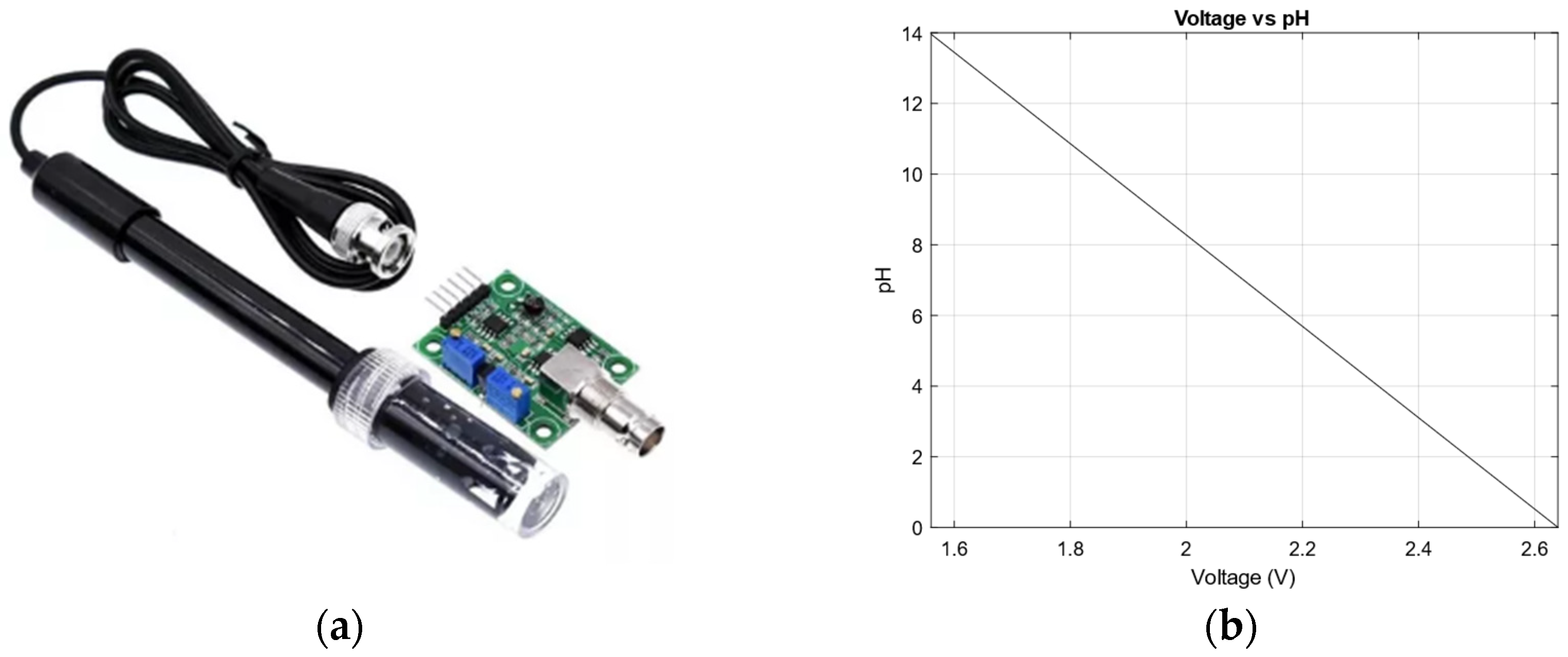
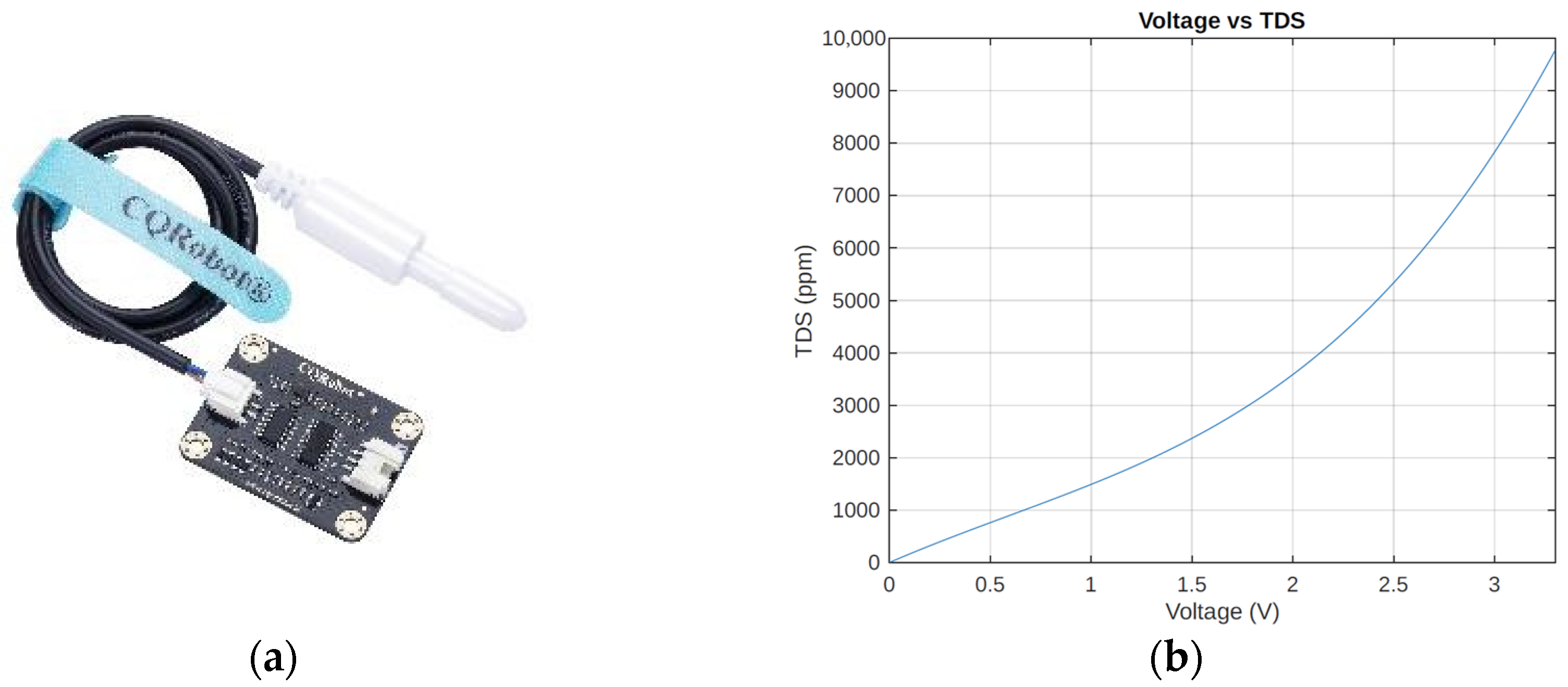
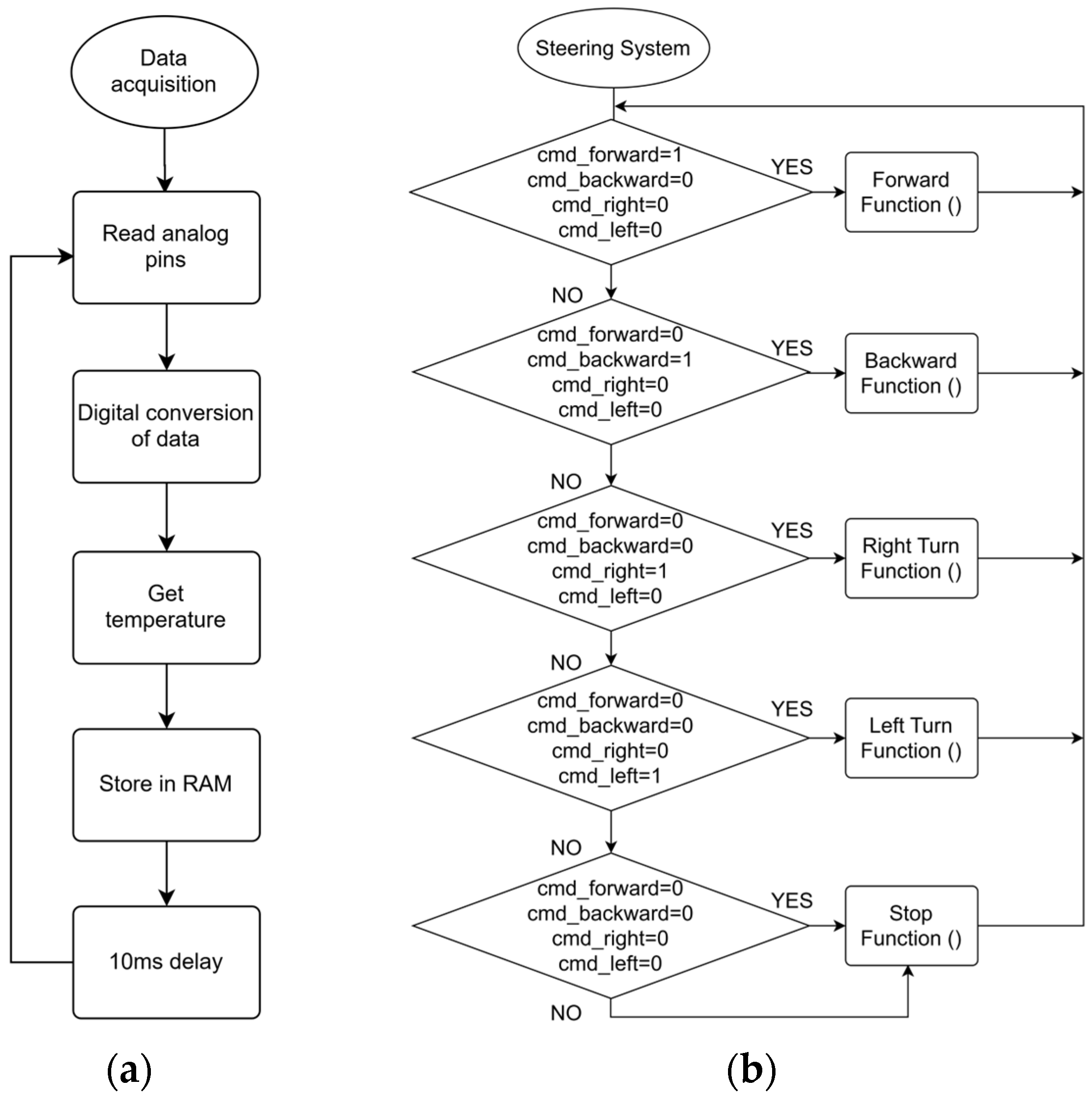



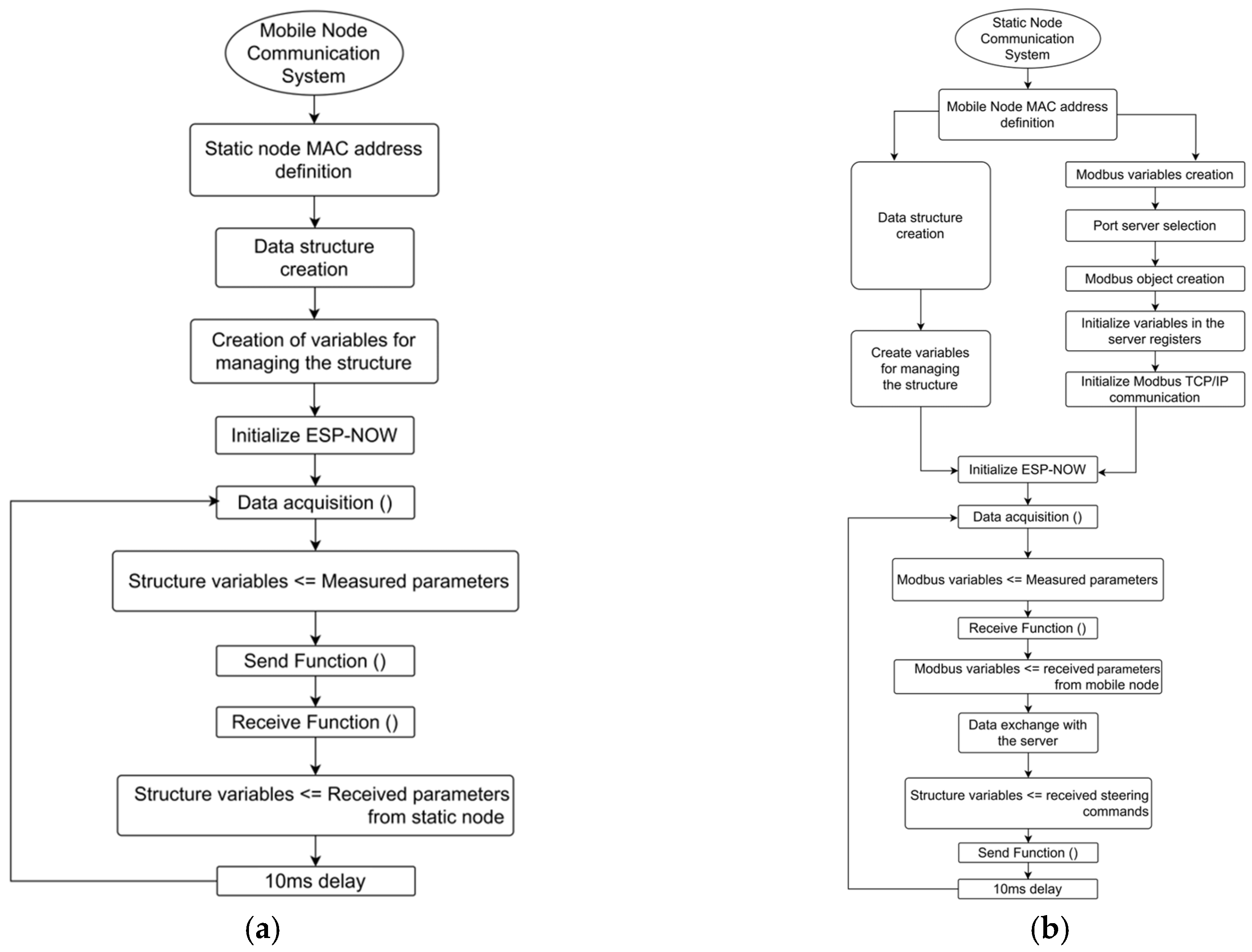

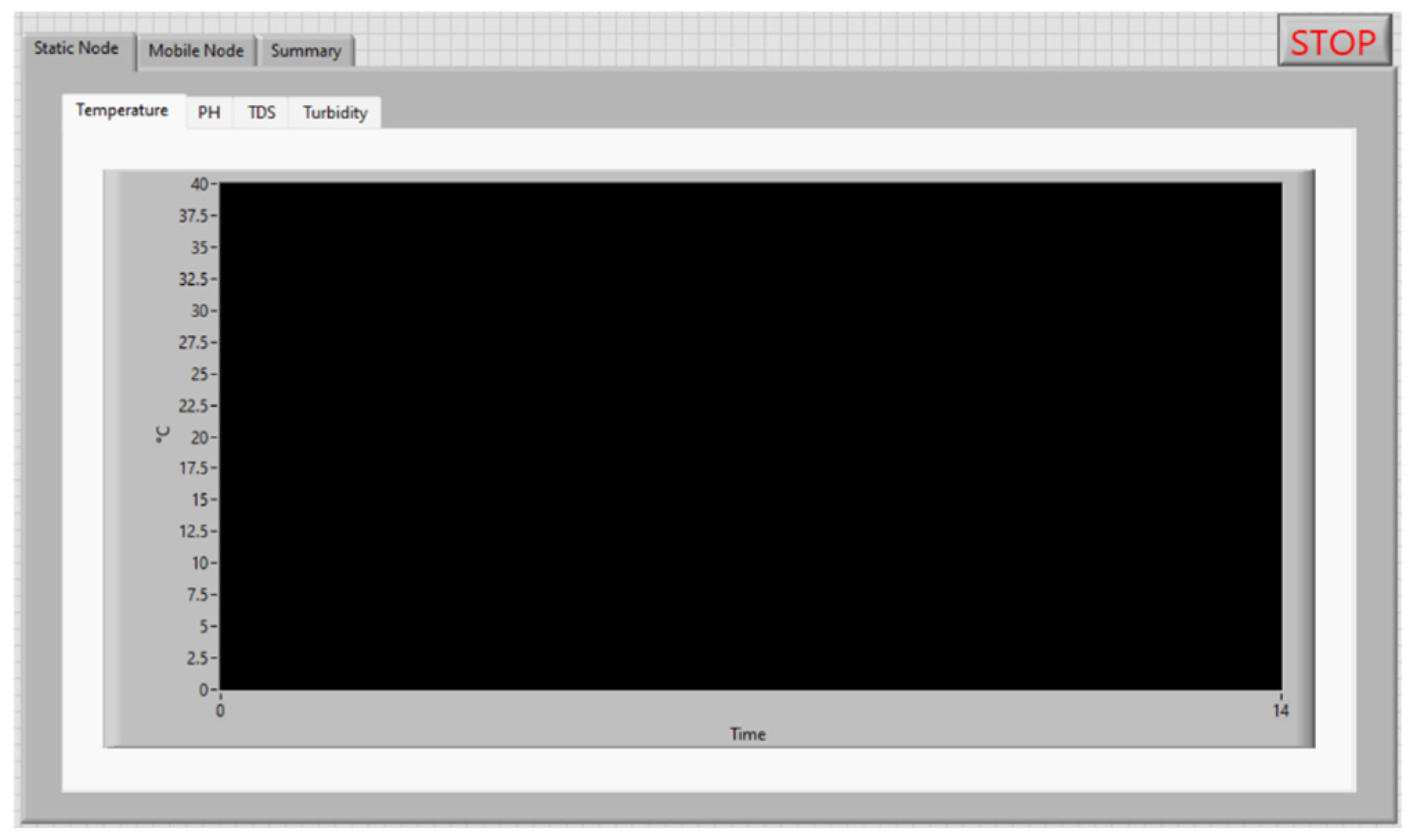

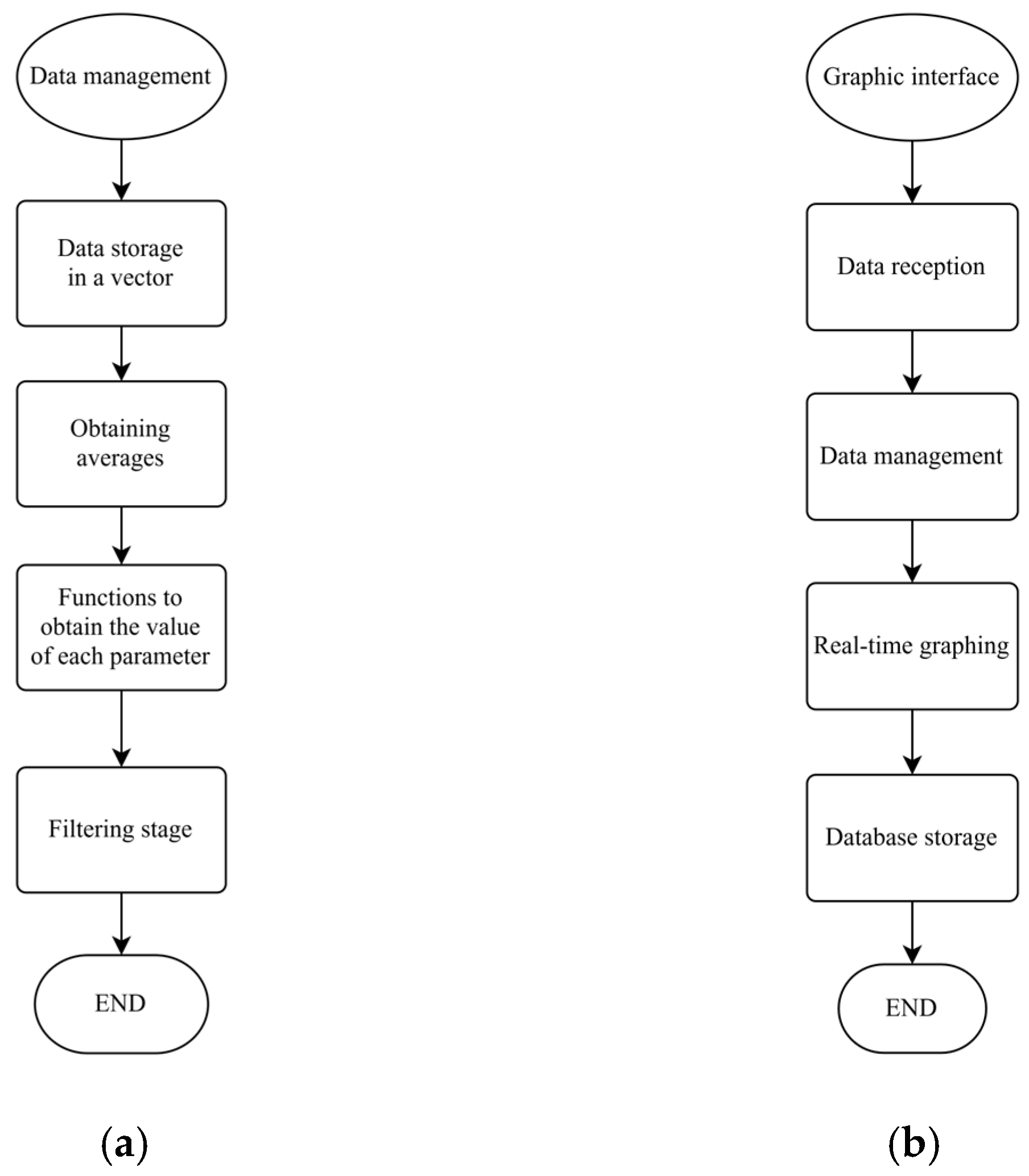
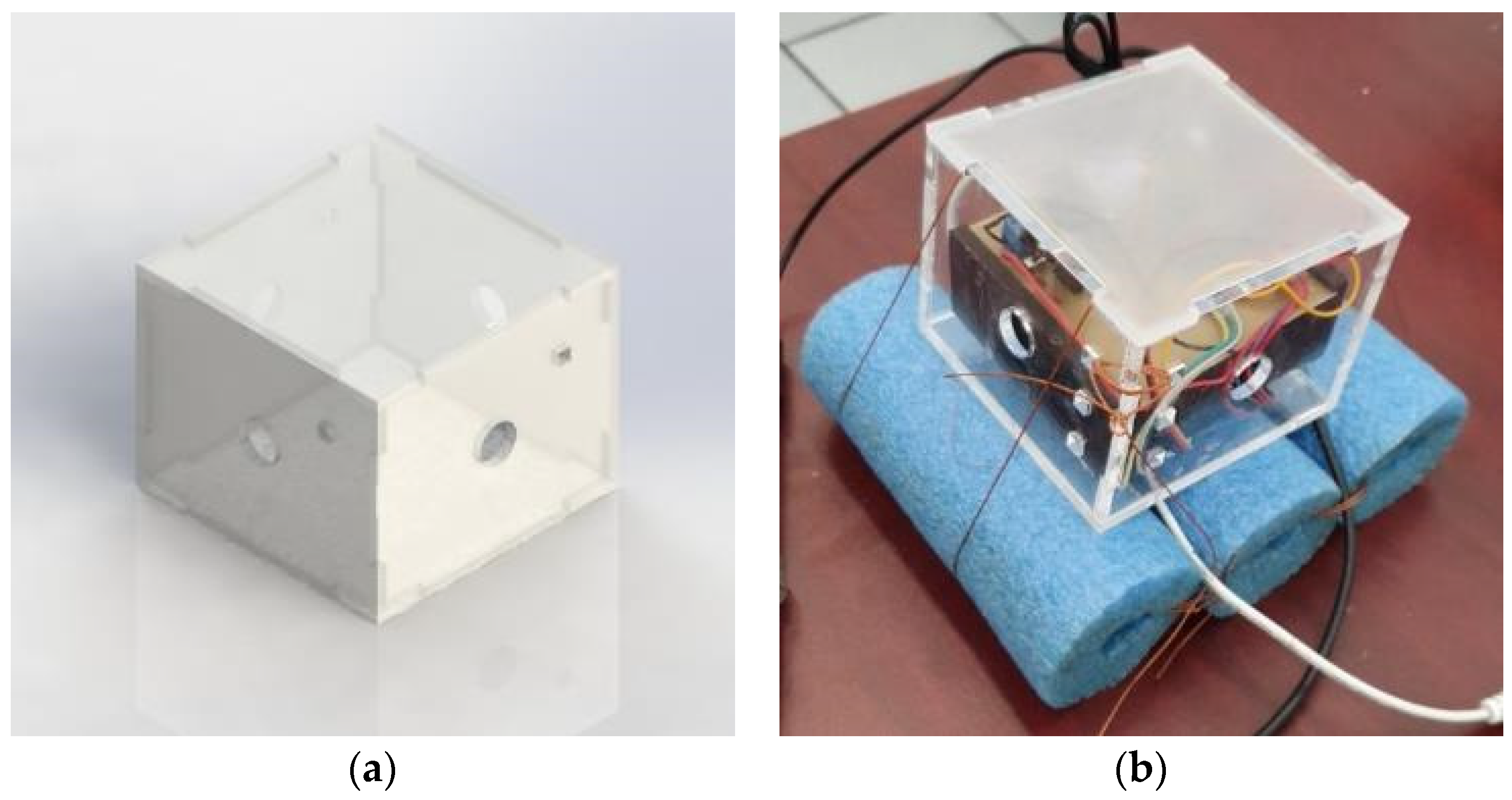
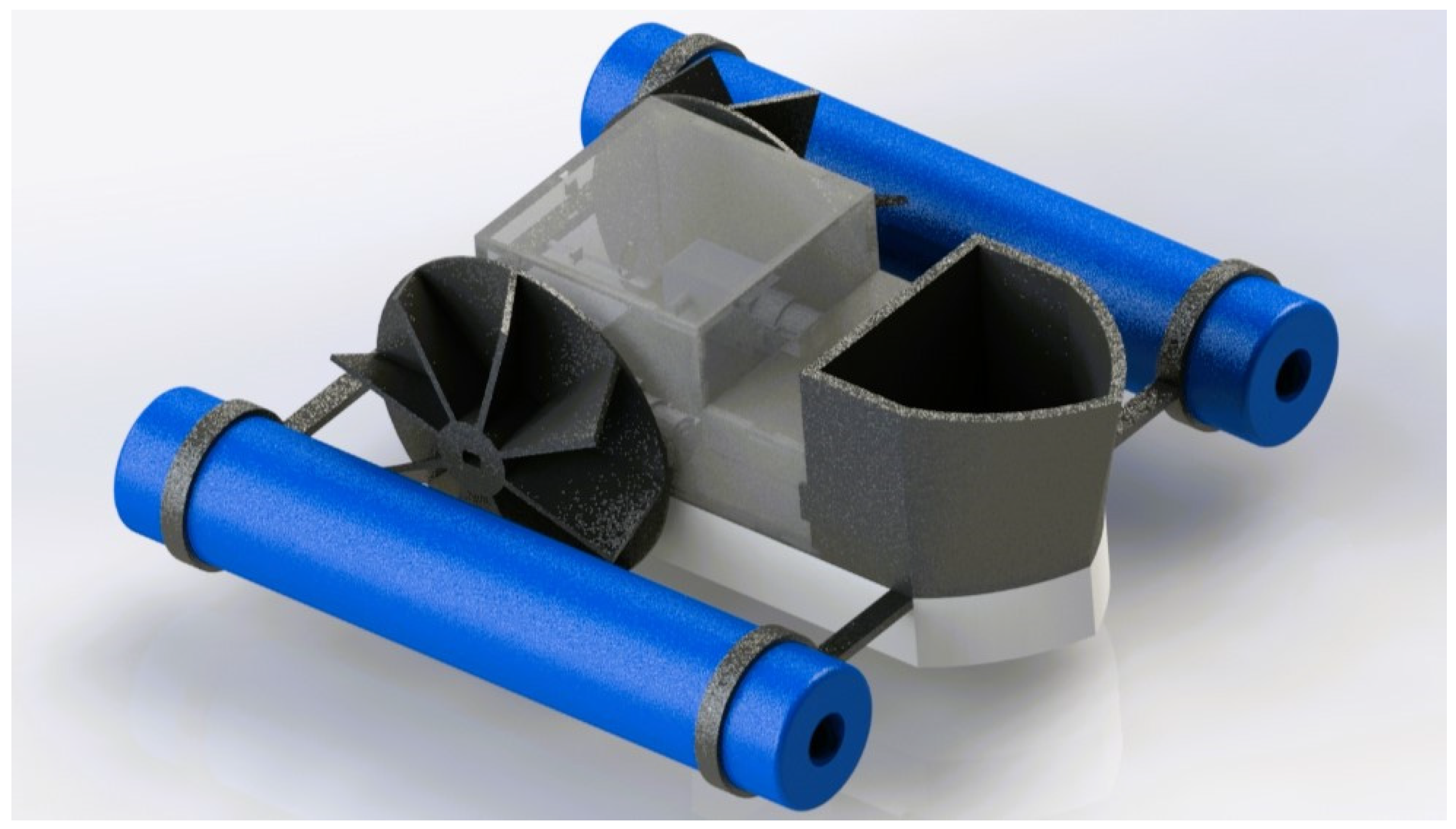
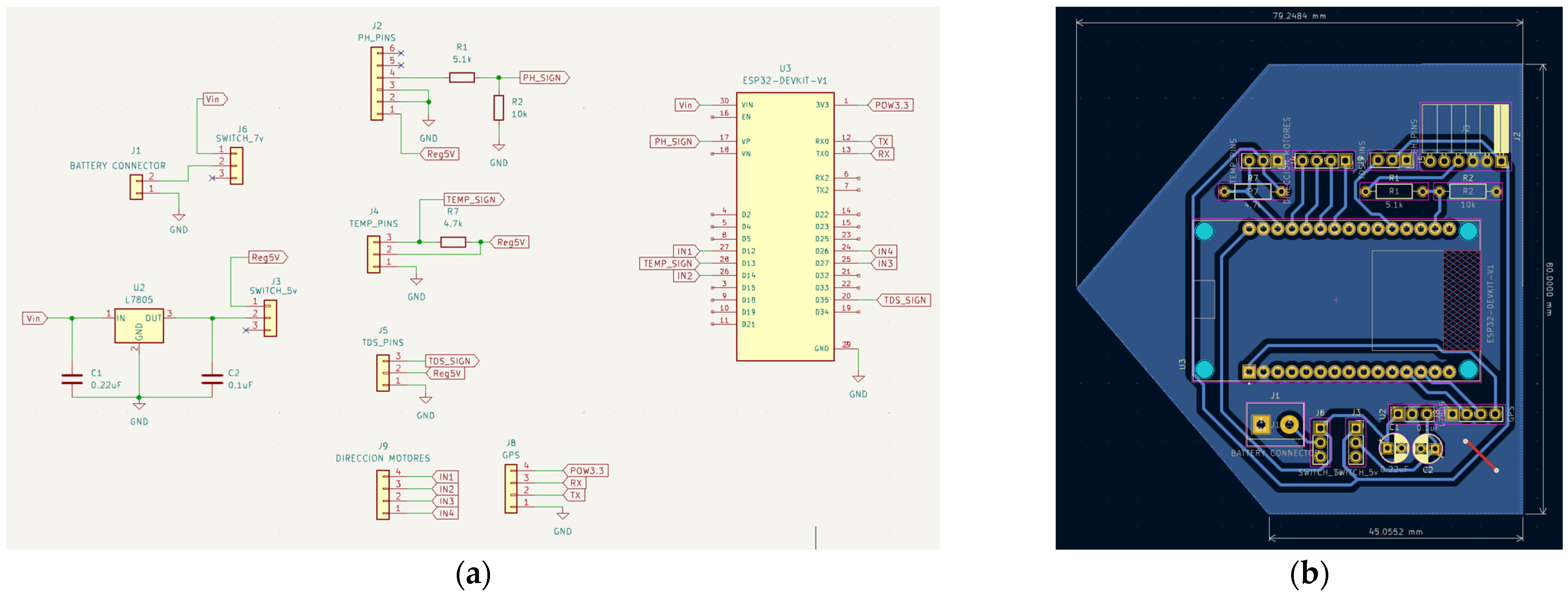
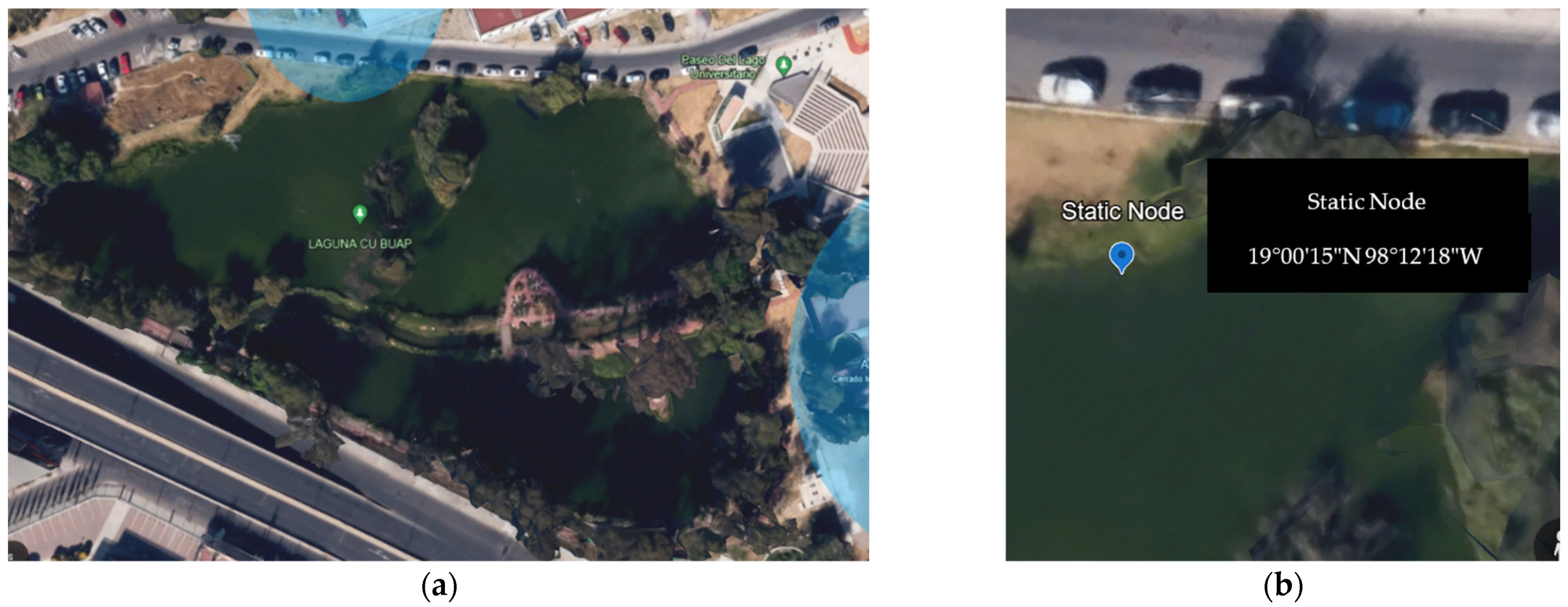
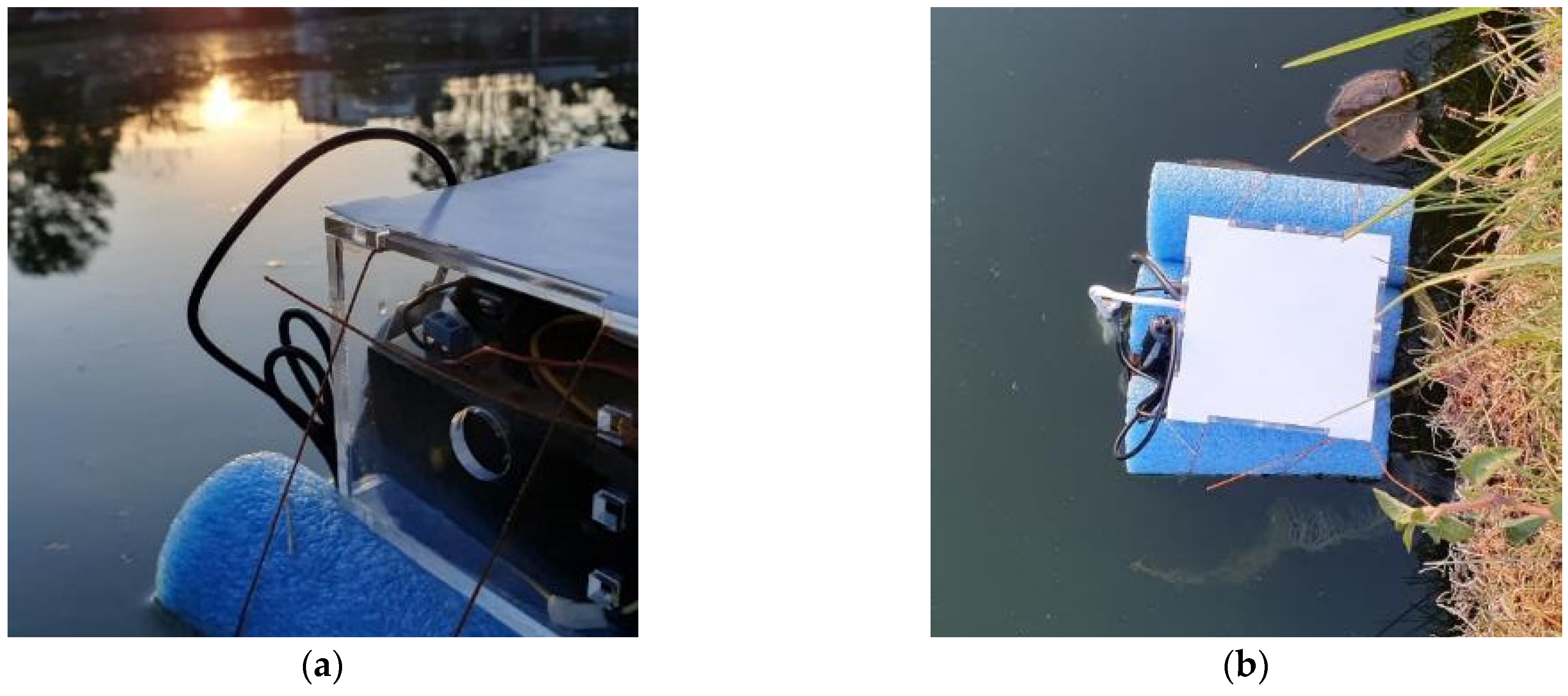
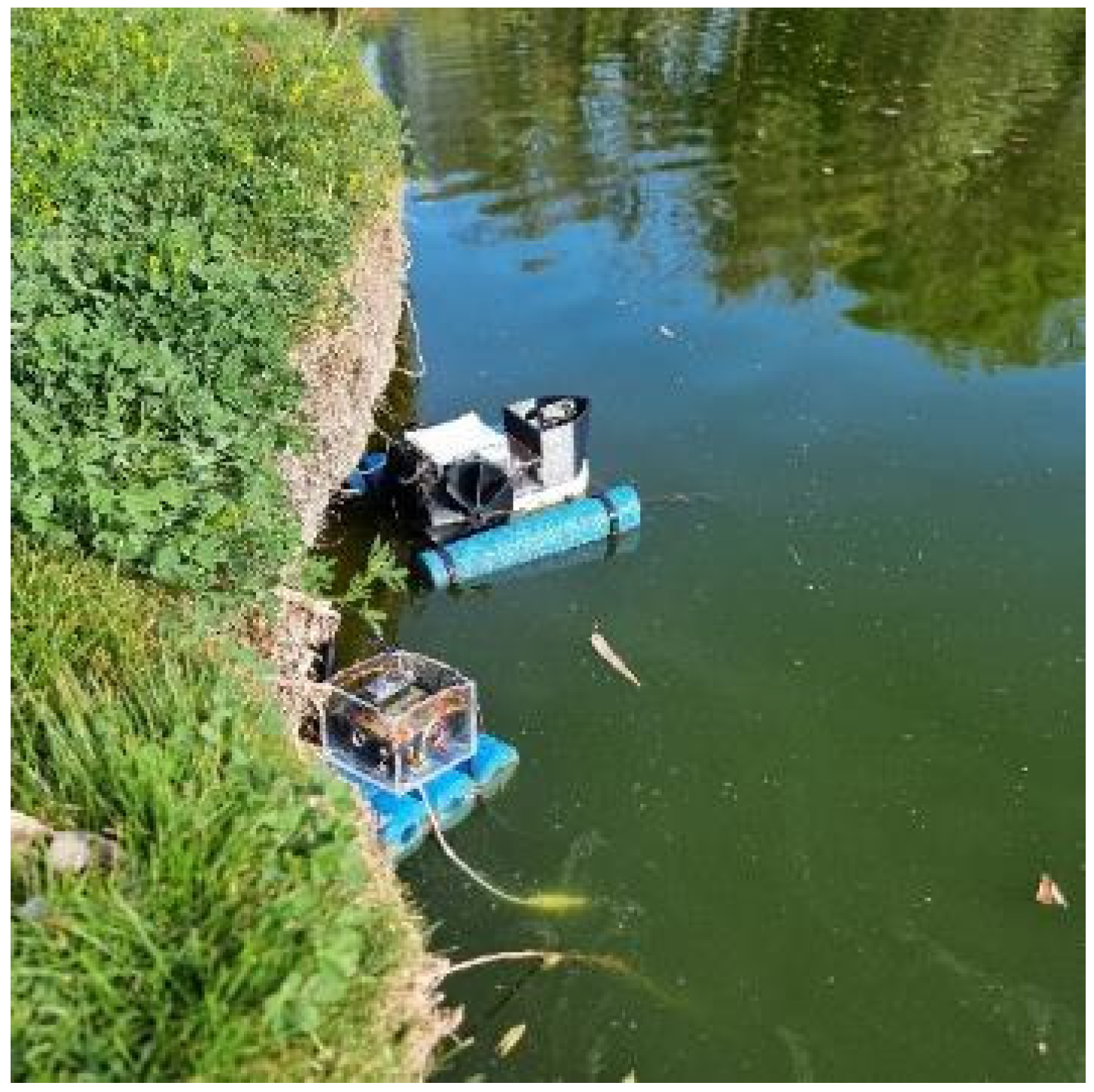
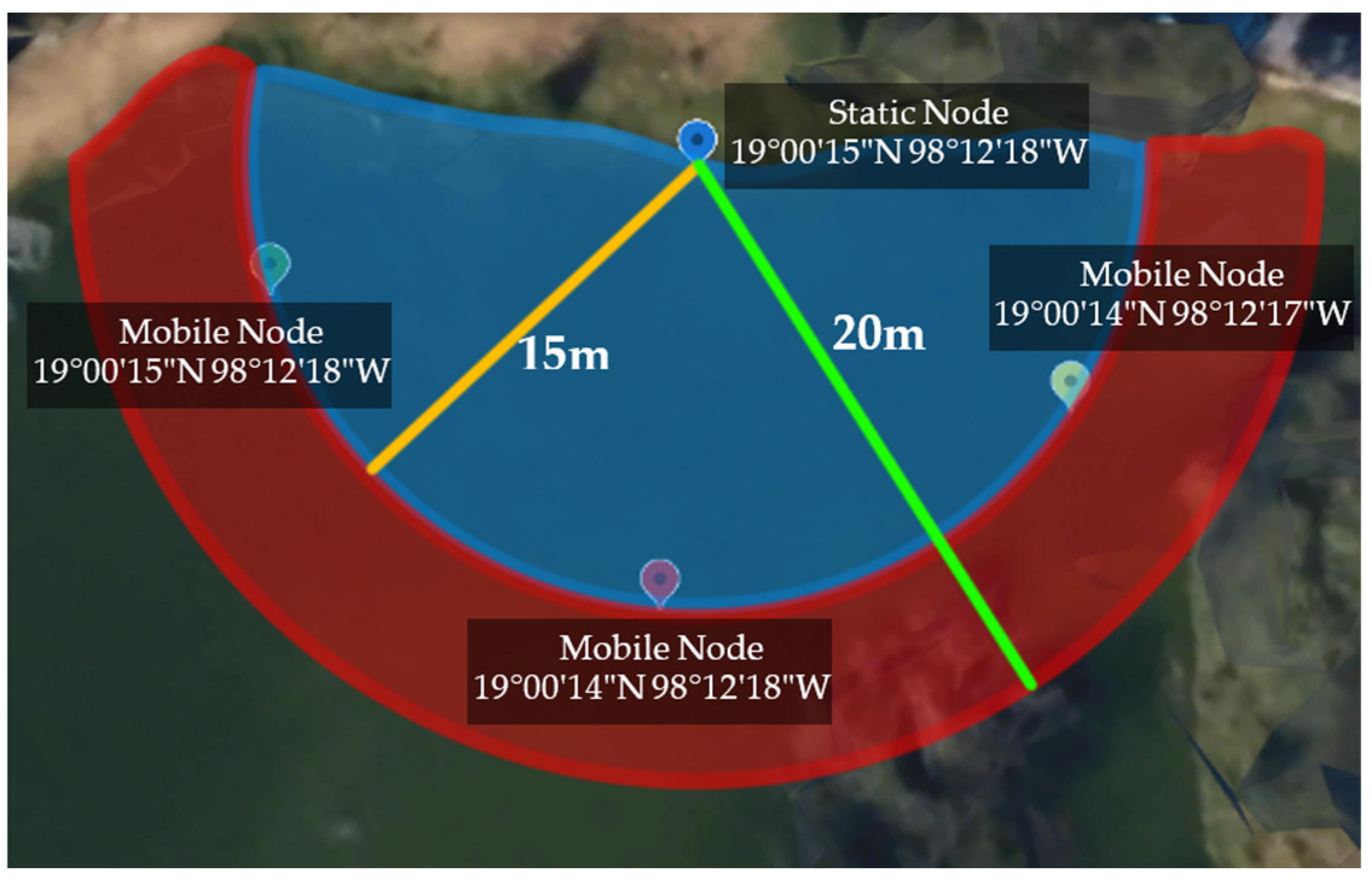
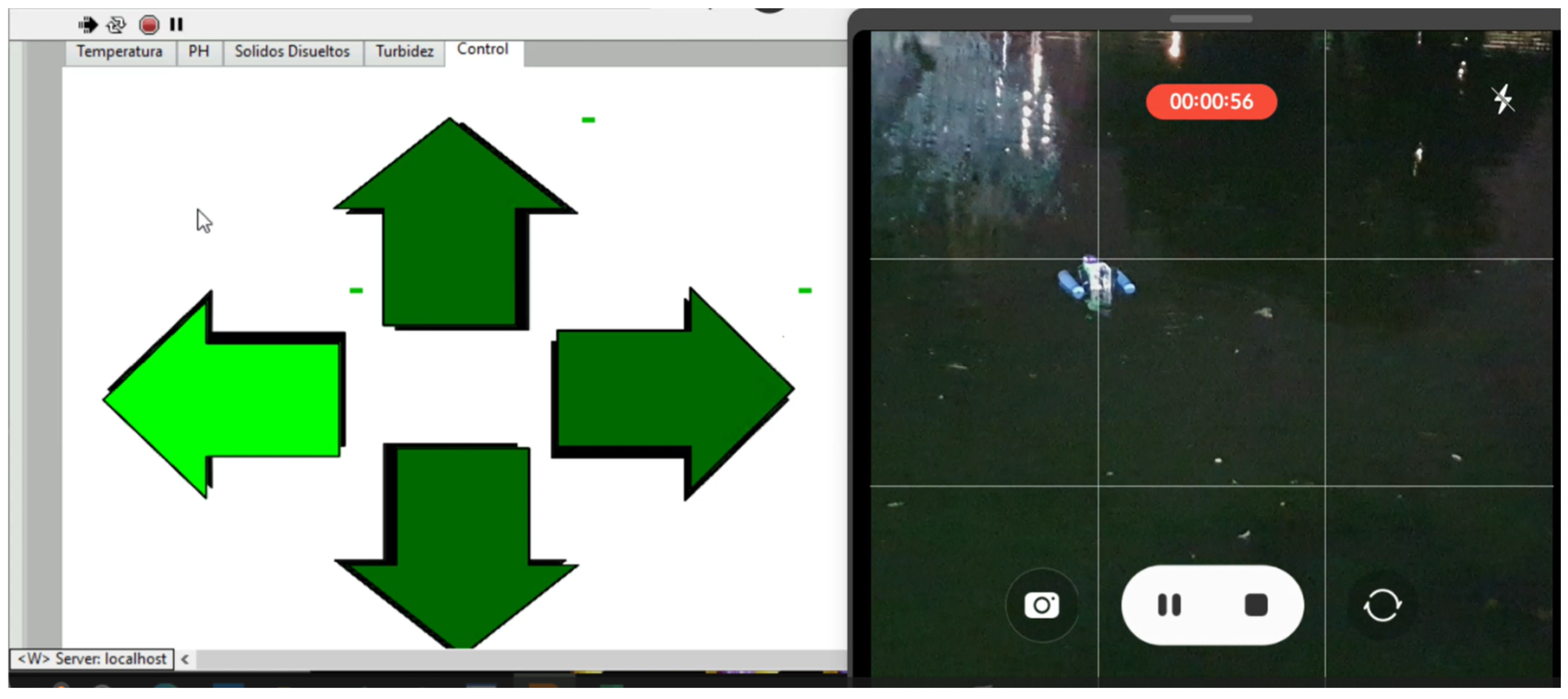

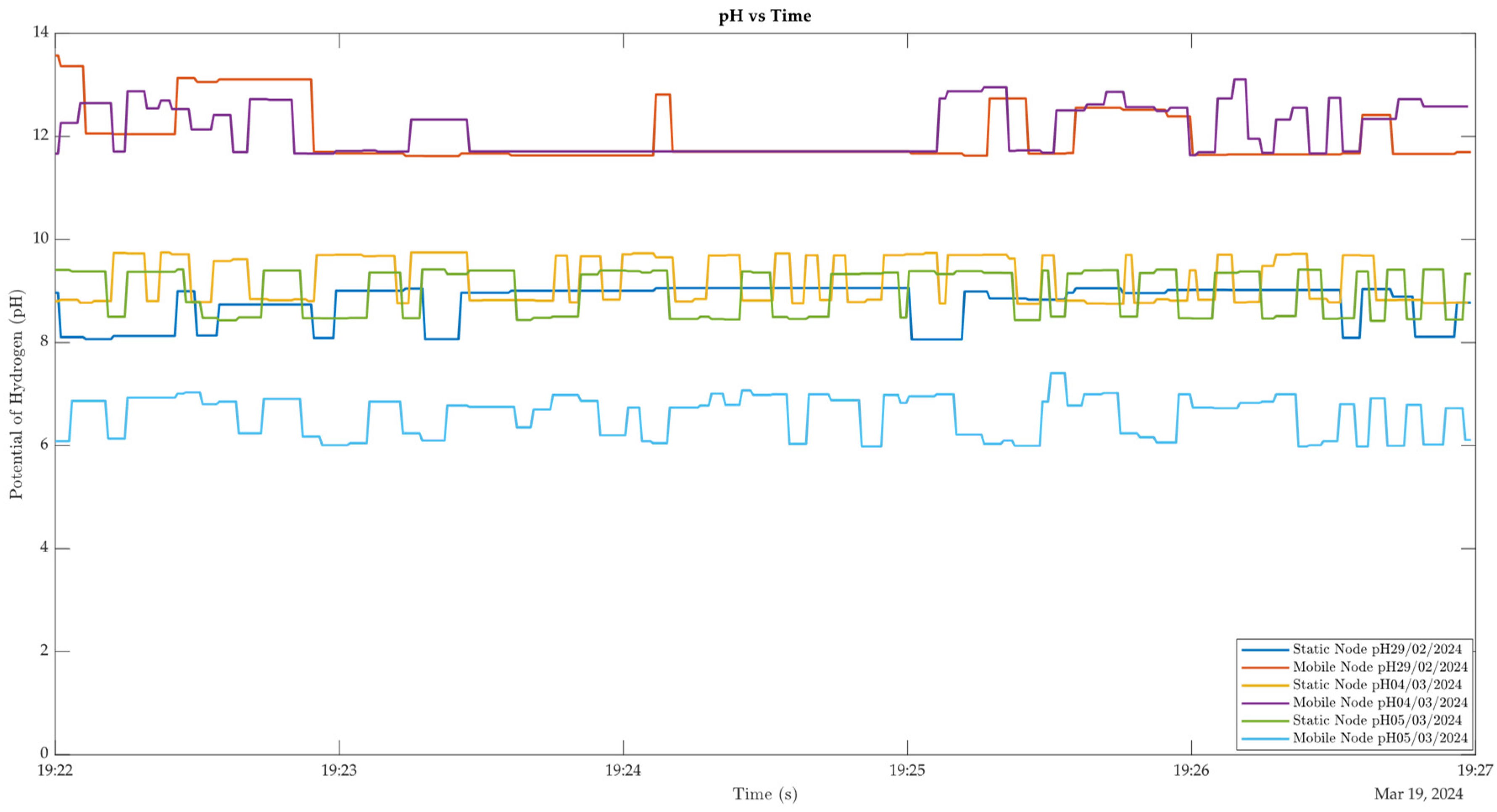
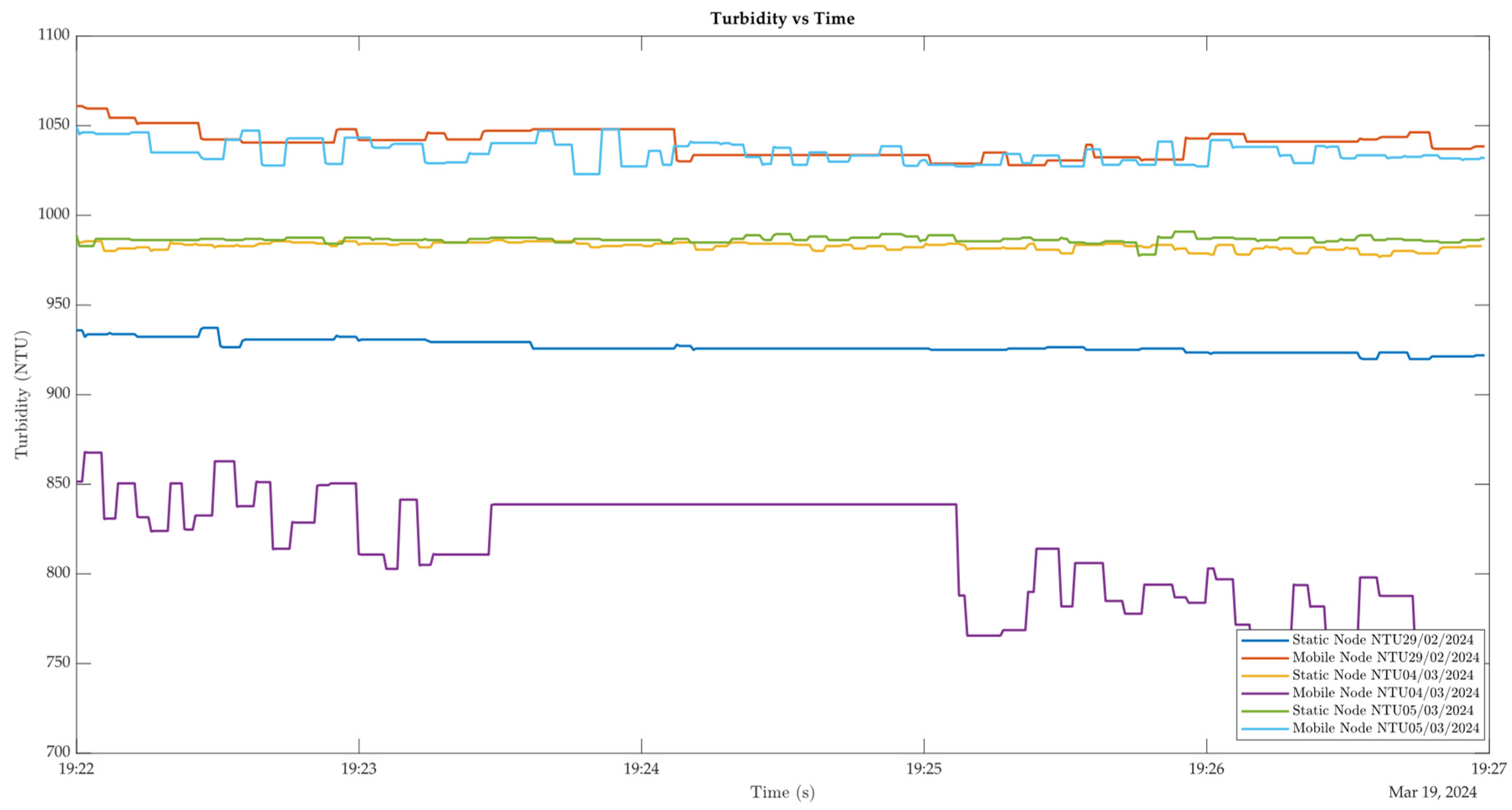

| Consulted Reference | Year | Monitored Parameters | Contribution | Pros and Cons |
|---|---|---|---|---|
| [35] | 2024 | pH Ammonium Conductivity Turbidity | A wireless sensor network (WSN) with two nodes was designed to monitor a water treatment plant, where IA techniques were integrated to predict concentrations of water parameters. | Pros: IA technique integration Tested in a water treatment plant Cons: Challenges in deployment in harsh environments Limited accuracy in real-time data delivery No mobile nodes were implemented. |
| [10] | 2023 | pH Temperature Turbidity Dissolved oxygen Soil moisture Liquid level | A wireless sensor network (WSN) with four nodes designed to monitor ecological wetlands within smart cities. It facilitates the collection and storage of environmental data in a database. | Pros: Good area coverage, thanks to 4 nodes Cloud backup Tested in ecological wetlands Cons: More energy consumption No mobile nodes were implemented. No real-time monitoring enabled |
| [8] | 2022 | pH Temperature Turbidity Dissolved oxygen | The developed system comprises a single fixed node that monitors water quality and sends alerts using GSM technology. | Pros: Alerts for the user Visual representation (LEDs) for parameters read Cons: No cloud backup Just one node No real-time monitoring enabled Tested in a non-natural environment |
| [36] | 2021 | pH Temperature Dissolved oxygen Salinity Liquid level | A WSN was designed to monitor a fishpond, utilizing the LoRa protocol for sensor nodes; it features cloud backup for the recorded parameters. | Pros: Long range area coverage Cloud backup Tested in a fishpond Cons: Additional device required for cloud uploading No real-time monitoring enabled No mobile nodes implemented |
| [37] | 2020 | pH Temperature Total dissolved solids | The system is based on one mobile wired node using the Ethernet protocol, and the gateway is connected to the server using the same protocol. | Pros: A mobile node implemented Real-time monitoring Tested in a natural environment Cons: Wired system Just one node |
| Distance (m) | Average RSSI (dB) | Packet Loss |
|---|---|---|
| 3 | −51 | 0/100 |
| 6 | −60 | 0/100 |
| 9 | −64 | 0/100 |
| 12 | −75 | 0/100 |
| 15 | −82 | 6/100 |
| 18 | −100 | 39/100 |
| 21 | −110 | 88/100 |
Disclaimer/Publisher’s Note: The statements, opinions and data contained in all publications are solely those of the individual author(s) and contributor(s) and not of MDPI and/or the editor(s). MDPI and/or the editor(s) disclaim responsibility for any injury to people or property resulting from any ideas, methods, instructions or products referred to in the content. |
© 2024 by the authors. Licensee MDPI, Basel, Switzerland. This article is an open access article distributed under the terms and conditions of the Creative Commons Attribution (CC BY) license (https://creativecommons.org/licenses/by/4.0/).
Share and Cite
López-Munoz, M.A.; Torrealba-Melendez, R.; Arriaga-Arriaga, C.A.; Tamariz-Flores, E.I.; López-López, M.; Quirino-Morales, F.; Munoz-Pacheco, J.M.; López-Marcos, F. Wireless Dynamic Sensor Network for Water Quality Monitoring Based on the IoT. Technologies 2024, 12, 211. https://doi.org/10.3390/technologies12110211
López-Munoz MA, Torrealba-Melendez R, Arriaga-Arriaga CA, Tamariz-Flores EI, López-López M, Quirino-Morales F, Munoz-Pacheco JM, López-Marcos F. Wireless Dynamic Sensor Network for Water Quality Monitoring Based on the IoT. Technologies. 2024; 12(11):211. https://doi.org/10.3390/technologies12110211
Chicago/Turabian StyleLópez-Munoz, Mauro A., Richard Torrealba-Melendez, Cesar A. Arriaga-Arriaga, Edna I. Tamariz-Flores, Mario López-López, Félix Quirino-Morales, Jesus M. Munoz-Pacheco, and Fernando López-Marcos. 2024. "Wireless Dynamic Sensor Network for Water Quality Monitoring Based on the IoT" Technologies 12, no. 11: 211. https://doi.org/10.3390/technologies12110211
APA StyleLópez-Munoz, M. A., Torrealba-Melendez, R., Arriaga-Arriaga, C. A., Tamariz-Flores, E. I., López-López, M., Quirino-Morales, F., Munoz-Pacheco, J. M., & López-Marcos, F. (2024). Wireless Dynamic Sensor Network for Water Quality Monitoring Based on the IoT. Technologies, 12(11), 211. https://doi.org/10.3390/technologies12110211









